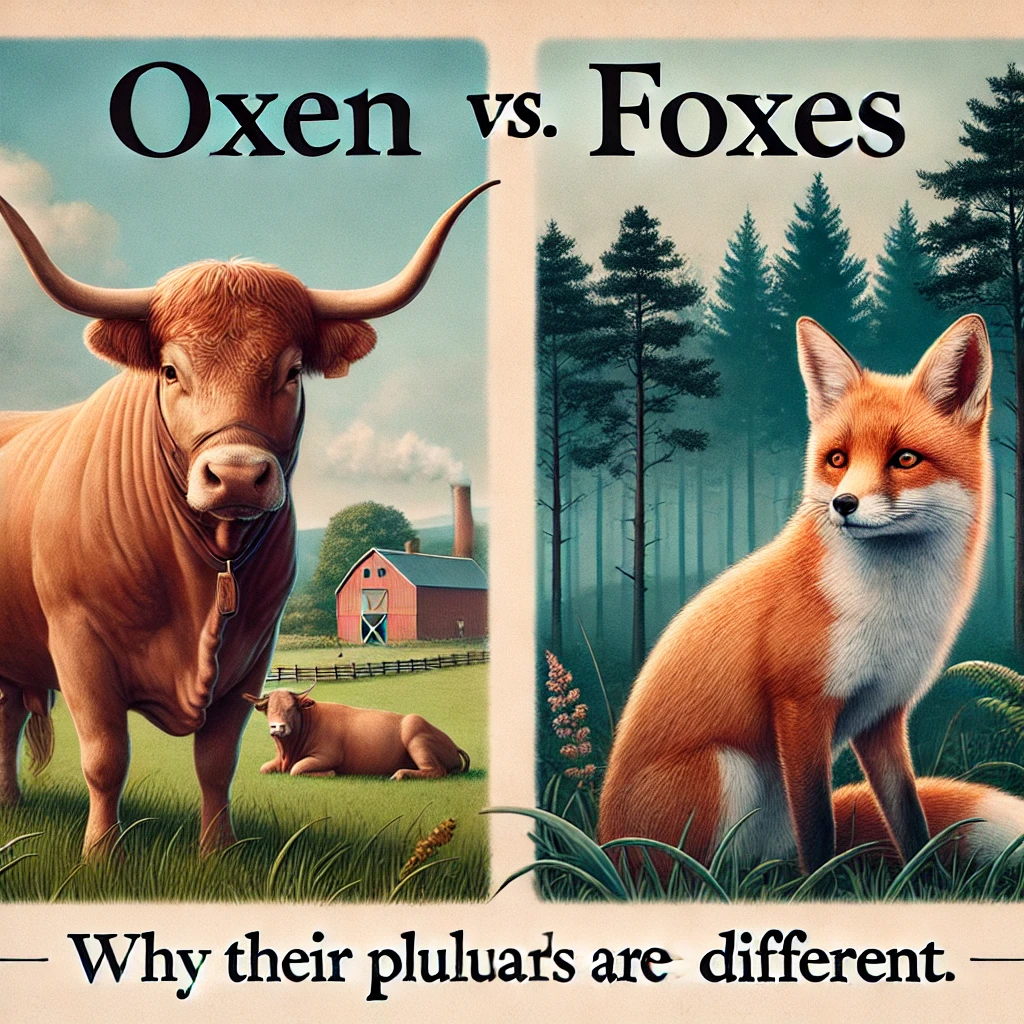Introduction
English is full of grammatical surprises, and one of the most perplexing inconsistencies is the pluralization of certain words. Why do we say “oxen” instead of “oxes”, yet we say “foxes” instead of “foxen”? Understanding these differences requires a deep dive into English plurals, linguistic history, and grammatical rules that have shaped the language over time.
This article explores the plural forms of “ox” and “fox,” explains their historical roots, and sheds light on irregular nouns in English. By the end, you’ll have a clearer understanding of “ox” and “fox,” how pluralization patterns have evolved.
Singular Forms of “Ox” and “Fox”
Before diving into pluralization, let’s establish their singular meanings:
- Ox: A large domesticated bovine used for farming and labor.
- Fox: A small, carnivorous mammal known for its cunning nature and bushy tail.
Both words belong to the animal world, yet they follow different pluralization rules due to language development over centuries.
Read More About This Article: Hoodie or Hoody? The Correct Spelling and Usage
Pluralization in English: A Quick Overview
Most English nouns follow a simple rule:
- Add “-s” or “-es” to make them plural.
- Dog → Dogs
- Cat → Cats
- Box → Boxes
However, some words follow irregular pluralization patterns, often rooted in Old English. Examples include:
| Singular | Plural |
|---|---|
| Mouse | Mice |
| Child | Children |
| Tooth | Teeth |
| Foot | Feet |
Strong vs. Weak Nouns in Old English
English once had two major noun types:
- Strong nouns: Regular words that took “-s” for plurals.
- Weak nouns: Words that followed different rules, often adding “-en” instead of “-s.”
Understanding this distinction helps explain why some words, like “ox,” retained their archaic endings while others, like “fox,” did not.
Why Is the Plural of Ox “Oxen”?
Historical Linguistic Roots
The word “ox” comes from the Old English “oxa.” Its plural was originally “oxan,” following weak noun declension rules. Over time, English dropped most “-en” plurals, but a few remained—like “oxen.”
Why Didn’t “Ox” Become “Oxes”?
During Middle English, many weak nouns switched to the standard “-s” plural. However, words like “ox” and “child” retained their historical endings due to common usage in rural and agricultural settings. The survival of “oxen” reflects its Anglo-Saxon roots and how older forms persisted in farming terminology.
Why Is the Plural of Fox “Foxes”?
Regular Pluralization Rules
Unlike “ox,” the word “fox” followed a different grammatical path. In Old English, its plural was “foxas”, which naturally evolved into “foxes.”
Why Not “Foxen”?
Words ending in “-x” typically follow a standard suffix addition rule:
- Box → Boxes
- Tax → Taxes
- Fox → Foxes
This pattern is a grammatical trend that solidified during Middle English, aligning foxes with the dominant pluralization system of the time.
Comparison: Oxen vs. Foxes
To better understand why “oxen” and “foxes” differ, let’s break it down:
| Word | Singular | Plural | Explanation |
|---|---|---|---|
| Ox | Ox | Oxen | Retains Old English weak noun plural with “-en.” |
| Fox | Fox | Foxes | Follows standard English rule of adding “-es.” |
Other Words with Irregular Plurals
Survivors of the “-en” Rule
While most English nouns abandoned “-en” plurals, a few remain:
- Children (from “cildru”)
- Brethren (from “brother”)
- Oxen (from “oxa”)
These words represent remnants of older grammatical structures still found in historical grammar.
Other Irregular Plurals in English
Some words don’t follow standard pluralization rules:
- Goose → Geese (vowel change)
- Mouse → Mice (mutation)
- Foot → Feet (linguistic shift)
These cases highlight how linguistic evolution shaped English pluralization.
The Influence of Old English on Modern Grammar
Many grammatical rules we follow today originated in Old English. Over time:
- Some words retained historical plurals (oxen, children).
- Others conformed to the dominant “-s” system (foxes, horses).
- English borrowed and adapted from Latin, French, and Germanic languages.
These influences explain why pluralization patterns can sometimes feel inconsistent.
Conclusion
The difference between “oxen” and “foxes” isn’t random—it’s rooted in historical grammar and linguistic evolution. While English moved toward standardizing plurals with “-s,” some words like “oxen” preserved their archaic endings due to their usage in agriculture and Old English remnants.
Understanding these irregular nouns helps us appreciate the complexity of language development. Next time you hear “oxen,” remember—you’re speaking a piece of history!
This comprehensive guide breaks down English plurals while keeping it informative and engaging. Let me know if you’d like any refinements! 🚀
